The contemporary method of township government arrived in Illinois in the middle of the nineteenth century. Replacing the commission method of county government, which Illinois had employed since statehood in 1818, the township innovation spread south and westward across Illinois, almost completely ousting the county commissioners.
Today, the commission format survives only in seventeen peripheral and largely rural Illinois counties. This book asserts that townships have persisted partly because they offer vital services at a reasonable cost to taxpayers, but also because of a vigorous defense of the method made by township officials with political connections in the Illinois general assembly. Discussing the successes and failures of attempts by abolition-minded citizens to eliminate all or individual townships in various counties, Township focuses on the spatial diffusion, periodic threats to, and determined persistence of the township system.
Today, the commission format survives only in seventeen peripheral and largely rural Illinois counties. This book asserts that townships have persisted partly because they offer vital services at a reasonable cost to taxpayers, but also because of a vigorous defense of the method made by township officials with political connections in the Illinois general assembly. Discussing the successes and failures of attempts by abolition-minded citizens to eliminate all or individual townships in various counties, Township focuses on the spatial diffusion, periodic threats to, and determined persistence of the township system.
